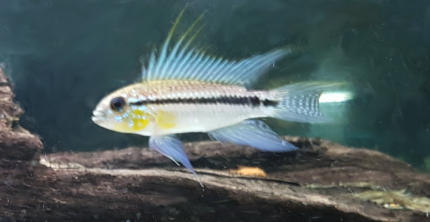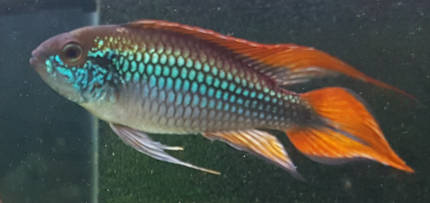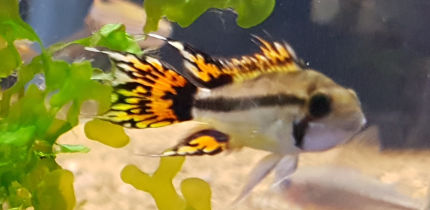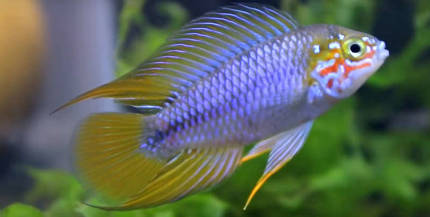Apistogramma Trifasciata dwarf cichlid (also known as the Three striped Apisto) are a striking species with the males being mainly blue and having a distinctive "spiky" dorsal fin.
Apistogramma Trifasciata have a reputation for being aggressive courters leading up to spawning as such some consideration needs to be given to tank layout and stocking levels. Hence Trifasciata should be considered an intermediate level of Apistogramma to keep.
About Apistogramma Trifasciata
Apistogramma Trifasciata Profile
Origin: Amazon basin, Paraguay and the Parana basin in Argentina
Size: Female: up to 2 inches (5 cm), Male: up to 2 1/2 inches (6 cm).
Minimum tank size: 20 gallons (75 litres).
Tank region: Bottom half of the tank.
Water temperature: 68 - 77 °F (20 - 25 °C)
Water conditions: PH between 5 to 7 is desirable. Soft water with a low TDS is preferred. Commercial bred varieties are less fussy.
Difficulty to keep: Intermediate level
In the wild Apistogramma Trifasciata are found over a wide region, spanning from southern parts of the Amazon Basin, Paraguay and the Parana basin in Argentina.
Given this species wide distribution in the wild they are also one of the most adaptable apisto when dealing with water parameters, particularly temperatures and are happy in water between 68 - 77 °F (20 - 25 °C).
Trifasciata live in slow moving tributaries which a sandy bottom and often contain decaying leaf litter.
Apistogramma Trifasciata is assigned the 'A' number A204 under the DATZ system.
Behaviour and Personality
Male Apsitogramma Trifasciata have a striking usually blue appearance and a "spiky" looking dorsal fin.
Like other Apsitogrammas Trifasciata generally stay within the bottom half of the water column and often sift the substrate as they look for food left over food from earlier feedings.
Apsitogramma Trifasciata are a dwarf cichlid and are generally peaceful and good community fish. But they can at times become aggressive - most often towards other males or during breeding.
As with most Apistogramma species Trifasciata do not form breeding pairs long-term, but only pair up when both parties are ready to spawn. Trifasciata males tend to be extremely polygamous, more so than most Apistogramma species.
Trifasciata males are well known for being very territorial towards other males or females with no spawning intentions. Hence it is not recommended to keep multiple males within the one aquarium unless it is quite large (40gal or greater) and well laid out.
If you are after more information managing Apistogramma aggression check out our article Apistogramma Aggression And How To Reduce It.
Apistogramma Trifasciata Male vs Female
Males
Male Apistogramma Trifasciata are larger and more colourful than their female counterparts.
The males have elongated rays at the front of the dorsal fin, long ventral fins and a round caudal fin.
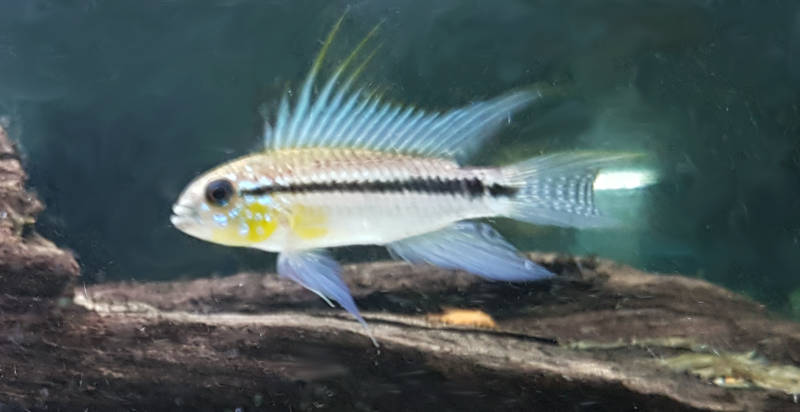
Females
As with other Apistogrammas female Trifasciata are smaller and less colourful, usually a dull yellow or washed out with more rounded fins. They become a much brighter more vibrant yellow when breeding.
Apistogramma Trifasciata Aquarium Setup
Tank Size
To keep a pair or Trio (1 male, 2 female) of Apistogramma Trifasciata a minimum tank size of 20 gallons (75 litres) is recommended, this would also allow for some tank mates, such as tetras. Refer to below tank mates section.
however it is important to ensure the tank is setup appropriately in order to minimises any possible aggression.
Aquarium Layout
Apistogrammas in general appreciate some hiding places and objects which break up line of sight within the aquarium. This is especially the case for Apistogramma Trifasciata which at times can be more aggressive than other species.
Hiding places and breaks in line of sight can be achieved by adding driftwood, rocks, caves, clumps of moss and other plants to the aquarium.
These distinct areas of the tank provide separate territories should males get aggressive such as during breeding.
For more information on managing aggression see - Apistogramma Aggression And How To Reduce It.
Substrate
In the wild Apistogramma Trifasciata are found in tributaries with sandy bottoms. Apistogrammas also enjoy sifting the sand from time to time as they look for food. So a sand substrate which mimics their natural habitat is recommended.
Best Apistogramma Trifasciata Tank Mates
Other small non aggressive fish are best. Tetras such as Ember Tetras, Loreto Tetras (and many more), as well as Dwarf Pencilfish are generally good tank mates for apistogrammas.
Generally Apistogrammas appreciate some tank mates, even just a small school of tetras to serve as dither fish will help them feel more secure.
For more detail on selecting appropriate Apistogramma tank mates check out or detailed article, Apistogramma Tank Mates.
Conclusion
Apistogramma Trifasciata have a striking appearance and can add a flash of colour to your aquarium.
They can however be a little more aggressive than other apistos especially when breeding so if you intend to house males and females in the same aquarium appropriate layout of the aquarium is essential to minimise aggression.
